Carbon nucleophiles - Study guides, Class notes & Summaries
Looking for the best study guides, study notes and summaries about Carbon nucleophiles? On this page you'll find 77 study documents about Carbon nucleophiles.
Page 3 out of 77 results
Sort by
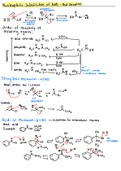
-
CHEM 215 Exam 2 Study Guide
- Summary • 13 pages • 2022
- Available in package deal
-
- $3.99
- 2x sold
- + learn more
This study guide will help you get an A on Exam 2 in CHEM 215 :) It is a summary of Exam 2 content containing colorful diagrams, drawings, and mechanisms. This study guide paired with practice problems will help any student succeed in this course. The study guide contains information from Exam 2 including: -Acylation mechanisms (strong base, weak base, acid catalyst, special cases) -Reactivity of different functional groups -Preparation and reactions of carboxylic acids, anhydrides, esters...

-
AQA A Level Chemistry 2022 Paper 2 SOLUTION 2023//2024
- Exam (elaborations) • 5 pages • 2023
-
- $9.99
- + learn more
How can we make polymers more flexible? - ANSWER By adding a plasticiser How do plasticisers make polymers more flexible? - ANSWER They stick between the chains and keep the polymers further apart from each other, weakening the van der Waals forces and lets chains slide more easily. Uses of Kevlar - ANSWER bulletproof and used in body armour. Uses of Nylon - ANSWER commonly used in textiles. Why are polymers strong? - ANSWER Polymers are bound by van der Waals forces. The intermolecula...
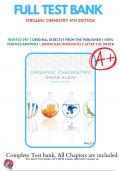
-
Test Bank for Organic Chemistry 4th Edition by David R. Klein | 9781119659594 |2021-2022 |Chapter 1-27 | All Chapters with Answers and Rationals
- Exam (elaborations) • 2151 pages • 2023
-
- $42.98
- + learn more
Test Bank for Organic Chemistry 4e 4th Edition by David R. Klein. ISBN-13: 9594 Full chapters test bank PDF TABLE OF CONTENTS 1 A Review of General Chemistry: Electrons, Bonds, and Molecular Properties 1 1.1 Introduction to Organic Chemistry 2 1.2 The Structural Theory of Matter 3 1.3 Electrons, Bonds, and Lewis Structures 4 1.4 Identifying Formal Charges 7 1.5 Induction and Polar Covalent Bonds 8 1.6 Reading Bond-Line Structures 11 1.7 Atomic Orbitals 14 1.8 Valence Bond Theory 17 1.9 Molecular...
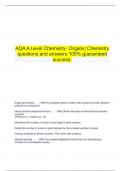
-
AQA A Level Chemistry- Organic Chemistry questions and answers 100% guaranteed success.
- Exam (elaborations) • 14 pages • 2024
-
- $13.49
- + learn more
AQA A Level Chemistry- Organic Chemistry questions and answers 100% guaranteed success. Empirical formula - ANS.The simplest whole number ratio of atoms of each element present in a compound How to find the empirical formula - ANS.Obtain the mass of each element present in grams (Element % = mass in g = m) Determine the number of moles of each type of atom present Divide the number of moles of each element by the smallest number of moles Co...
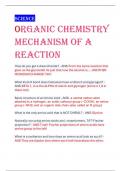
-
Science 0rganic chemiStry mechaniSm of a reaction
- Exam (elaborations) • 14 pages • 2024
-
- $17.99
- + learn more
Science 0rganic chemiStry mechaniSm of a reaction How do you get a disaccharide? - ANS-From the same reaction that gave us the glycoside! Its just that now the alcohol is.....ANOTHER MONOSACCHARIDE! YAY! What kind of bond does Cellulose have vs Starch and glycogen? - ANS-BETA 1, 4 vs the ALPHA of starch and glycogen (some α 1,6 in there too!) Basic structure of an Amino Acid - ANS- a central carbon atom attached to a hydrogen, an acidic carboxyl group (−COOH), an amino grou...
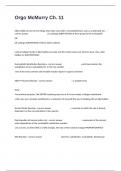
-
Orgo McMurry Ch. 11 Actual Questions And Answers Verified.
- Exam (elaborations) • 7 pages • 2024
- Available in package deal
-
- $12.99
- + learn more
Alkyl halides do one of two things when they react with a nucleophile/base, such as a hydroxide ion... - correct answer (1) undergo SUBSTITUTION of the X group by the nucleophile OR (2) undergo ELIMINATION of HX to yield an alkene carbon-halogen bonds in alkyl halides are polar and the carbon atoms are electron-poor, thus, alkyl halides are ELECTROPHILES Nucleophilic Substitution Reactions - correct answer -each st...
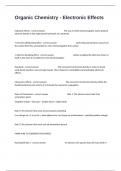
-
Organic Chemistry - Electronic Effects Assessment Questions And Answers.
- Exam (elaborations) • 2 pages • 2024
- Available in package deal
-
- $12.99
- + learn more
Inductive effects - correct answer The way in which electronegative atoms polarise electron density in the single bond framework of a molecule -I electron withdrawing effect - correct answer atoms that pull electrons away from the carbon that they are bonded to. more electronegative than carbon +I electron donating effect - correct answer carbon is pulling the electrons closer to ...
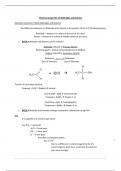
-
Chemical properties of Aldehydes and Ketones
- Exam (elaborations) • 45 pages • 2024
-
- $10.99
- + learn more
Chemical properties of Aldehydes and Ketones Reactions common to both Aldehydes and Ketones The difference between an Aldehyde and a Ketone is the position of the C=O (Carbonyl group). Aldehyde – always on a carbon at the end of the chain Ketone – Always on a carbon at middle carbon of the chain 1. BOTH Aldehydes and Ketones can be reduced Aldehyde reduced to Primary Alcohol Reducing agent = Sodium tetrahydroborate III (NaBH4) Ketone reduced to Secondary Alcohol Reduction Oxidisation ...
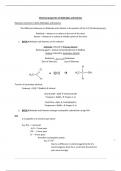
-
Chemical properties of Aldehydes and Ketones
- Exam (elaborations) • 45 pages • 2024
-
- $17.99
- + learn more
Chemical properties of Aldehydes and Ketones Reactions common to both Aldehydes and Ketones The difference between an Aldehyde and a Ketone is the position of the C=O (Carbonyl group). Aldehyde – always on a carbon at the end of the chain Ketone – Always on a carbon at middle carbon of the chain 1. BOTH Aldehydes and Ketones can be reduced Aldehyde reduced to Primary Alcohol Reducing agent = Sodium tetrahydroborate III (NaBH4) Ketone reduced to Secondary Alcohol Reduction Oxidisatio...
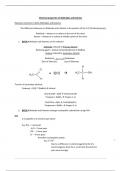
-
Chemical properties of Aldehydes and Ketones
- Exam (elaborations) • 45 pages • 2024
-
- $12.49
- + learn more
Chemical properties of Aldehydes and Ketones Reactions common to both Aldehydes and Ketones The difference between an Aldehyde and a Ketone is the position of the C=O (Carbonyl group). Aldehyde – always on a carbon at the end of the chain Ketone – Always on a carbon at middle carbon of the chain 1. BOTH Aldehydes and Ketones can be reduced Aldehyde reduced to Primary Alcohol Reducing agent = Sodium tetrahydroborate III (NaBH4) Ketone reduced to Secondary Alcohol Reduction Oxidisatio...

$6.50 for your textbook summary multiplied by 100 fellow students... Do the math: that's a lot of money! Don't be a thief of your own wallet and start uploading yours now. Discover all about earning on Stuvia


